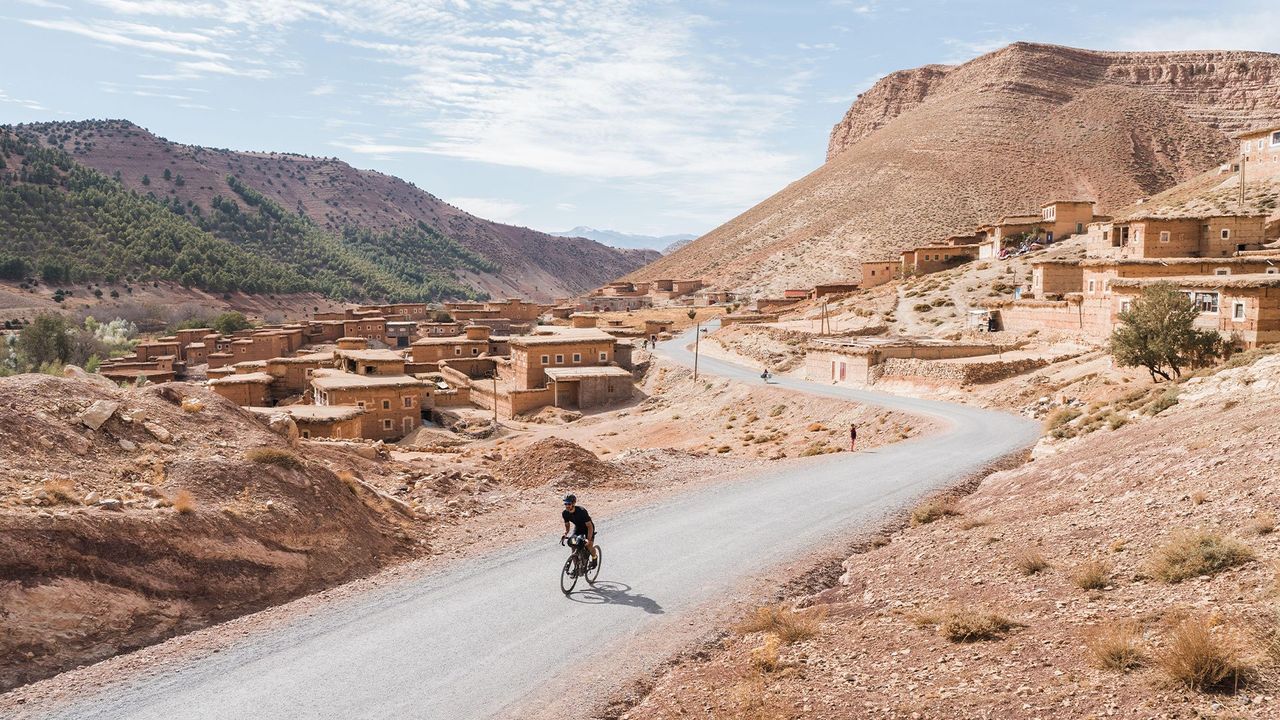From arid deserts and snow-capped peaks to forgotten villages and Mediterranean shores, Morocco’s new cross-country cycling trail invites travellers to experience the nation’s unseen soul.
A route less travelled

High in Morocco’s rugged Atlas Mountains, a shepherd in a white robe offered a knowing smile and a simple warning: “No route, no route!” He pointed toward the narrow canyon my cycling partner and I were pushing through, a stretch of rough trail that, by most standards, barely qualified as a path. But we weren’t lost — we were following a new kind of trail, one born not from tarmac or tourist guides but from ancient caravan routes and local shepherd tracks.
We were riding the Route of Caravans: Morocco Traverse (North) — an 837km off-road cycling route that begins in the remote mountain town of Imilchil and winds north through mountain ranges and traditional Amazigh villages before reaching the coastal city of Tangier. It’s the second half of a newly completed cross-country cycling journey that spans over 2,100km from the southern town of Tiznit to the Strait of Gibraltar, linking the Sahara to the sea. Designed for “bikepackers” — off-road cyclists carrying their own gear — the route offers a way to move slowly and deliberately through the heart of Morocco, bypassing the well-worn tourist circuit in favour of raw, immersive travel.
Riding through culture and history
What sets the Route of Caravans apart isn’t just the scenery — although that alone is remarkable. The trail traces the echoes of Morocco’s past, following paths once walked by camel caravans and seasonal nomads. These ancient corridors are still in use today by Amazigh communities who have lived in these mountains for millennia. Along the trail, I passed shepherds tending flocks on rain-fed pastures, and women foraging wild herbs in alpine meadows.

In small villages too remote to be marked on a map, I was greeted with “azul” — a Tamazight word meaning “from the heart.” The anthropomorphic yaz symbol, representing freedom and Amazigh identity, was etched onto shepherd huts and painted onto adobe homes. In these moments, the trail felt less like a cycling route and more like a journey through time — a way to see not just Morocco’s landscape, but its living culture.
An antidote to overtourism
Morocco is no stranger to tourism. In 2024 alone, the country welcomed 17.4 million visitors — a 20% rise from the year before. Cities like Marrakech have seen exponential growth, prompting concerns over overtourism. But on the Route of Caravans, the story is different. In towns like Boumia, local residents estimate they see fewer than a dozen tourists each month.
It’s this sense of solitude and authenticity that draws cyclists in. One afternoon in Boumia, a young man named Nabil, excited to practice his English, invited us to his home for lunch. Such spontaneous encounters — part hospitality, part human connection — are commonplace on the trail, where travellers often rely on local advice for food, water, or simply directions.
From vision to reality
Creating a route through some of the country’s most remote terrain wasn’t easy. Evan Christenson, the American cyclist who designed the northern portion of the trail for the website Bikepacking, spent six weeks in spring 2024 riding satellite-spotted trails, donkey tracks, and shepherd paths. “I had a pretty good idea of where I wanted to go,” he explained, “and if it didn’t go through, I’d turn around and try again.”
The digital map Christenson created now guides cyclists across Morocco’s untamed terrain, with notes on food stops, water sources, and wild camping zones. Fortunately for travellers, Morocco’s rural areas tolerate wild camping, and our own campsites ranged from pine forests to rocky canyons and even inside a crumbling mudbrick ruin. One memorable night, we camped under cedar trees in the Middle Atlas and watched endangered Barbary macaques leap between the branches as the sun set.
More than a physical journey
There’s something uniquely intimate about travelling by bicycle. It slows you down, demands resilience, and invites vulnerability. “You’re more open to the world when you’re on a bike,” said Sarah Swallow, a U.S. cyclist who completed the southern 1,266km stretch of the route earlier this year. “You need help sometimes, and people respond to that. You lean on each other.”
On our ride, we met other cyclists taking on the challenge in their own way. Germans Julia Winkelbach and Christian Wagner were riding the entire 2,103km route from Tangier to Tiznit, braving Saharan sandstorms and carrying up to 20 litres of water at a time. Their tales of desert camping and close encounters with scorpions reminded us just how varied — and extreme — Morocco’s terrain can be.
As they pedalled southward into the desert, we were climbing into the green folds of the Rif Mountains, where soft winds carried the scent of the Mediterranean. The stark contrast between these environments — the parched dunes of the south and the lush, sea-sprayed hills of the north — captures the geographic poetry of the route.
A final pause by the sea
As we neared the journey’s end, the world began to change once again. Traffic thickened, towns grew larger, and signs of mass tourism reappeared. But before reaching Tangier’s bustling ferry terminal, we made one last detour: a quiet stretch of coastline far from the crowds. We pitched our tent on a sandy beach, the Mediterranean at our feet and the Atlas mountains far behind. As Venus flickered in the darkening sky, we watched the sun dip behind the horizon — our ride complete.
The Route of Caravans isn’t just a cycling trail. It’s a new invitation to see Morocco through a different lens — not through the grand monuments or curated medinas, but through quiet forests, ancient villages, and paths made by people who live far from the tourist trail. It’s a ride into the unknown, and perhaps, a little deeper into the soul of a country.




